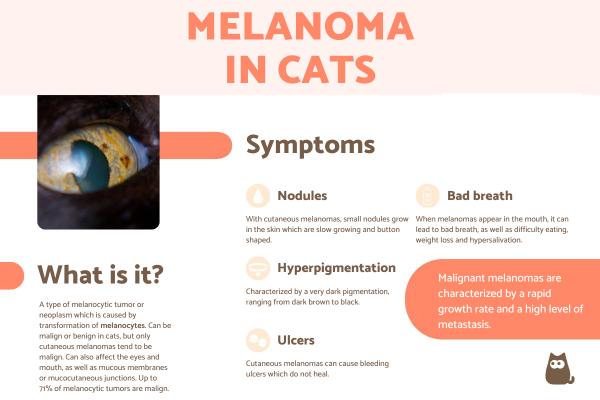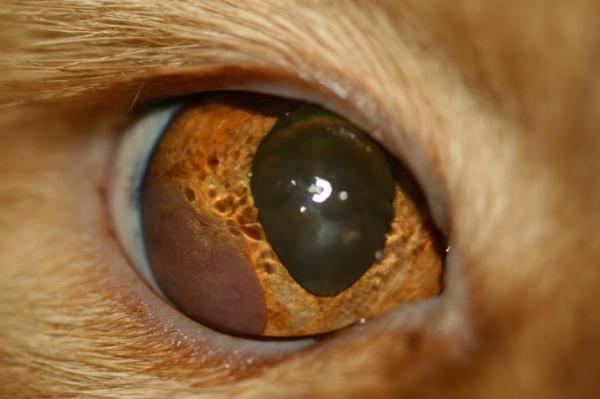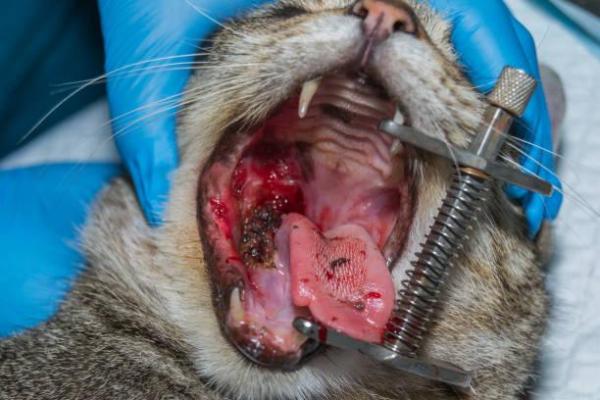Melanoma in Cats - Symptoms and Treatment



See files for Cats
Melanoma in cats is a type of skin cancer that can also develop in the eyes, mucous membranes or mucocutaneous junctions. The latter is the transitional area between mucous membranes and skin. Although melanomas are always malignant in human medicine, we can find both benign and malignant melanoma in cats. When cancerous, malignant melanomas tend to be aggressive and have a high risk of metastasis. This means they can invade other tissues and threaten the life of the cat, in addition to harming the affected areas.
AnimalWised looks at the symptoms, treatment and prognosis of melanoma in cats. We discover what we might expect if our cat develops this disease, particularly in terms of life expectancy.
What is melanoma in cats?
A melanoma is a type of neoplasm that affects melanocytes. These are the cells in the skin and eyes that are responsible for producing the pigment known as melanin. These neoplasia usually form into masses known as tumors.
In cytology, the biological behavior of melanomas means they can appear rounded, but they are not round cell tumors. Since they can invade mesenchymal tissues, they are sometimes mistakenly considered a mesenchymal cell tumor. However, they are considered a type of melanocytic tumor, themselves a type of neuroectodermal tumor because melanocytes originate from the neural crest.
Melanocytic tumors are relatively uncommon in cats, being more prevalent in dogs and horses. Between 29% to 49% of these tumors are benign, meaning up to 71% are malignant tumors like melanoma[1]. These tumors are usually located on the head, ears, eyelids and eyes of cats, with the eyes being the most frequently affected area. In fact, melanocytic neoplasia are the most common type of feline ocular tumor[2].
As in people and dogs, there is no clear evidence that exposure to ultraviolet rays is a predisposing factor for the development of melanomas. About 50% of the cases of cutaneous melanomas described in cats have been detected in animals without access to the outdoors. However, this does not mean it might not be a contributing factor.
Discover another type of malignant tumor which affects the feline facial area with our article on nasal cancer in cats.
Symptoms of melanoma in cats
The clinical picture of feline melanomas differ depending on whether they are benign or malignant. Let's look at both cases:
Symptoms of benign melanomas in cats
They usually appear as small, slow-growing, button-shaped nodular formations located on the skin. They are not usually attached to deep tissues. Benign melanomas in cats are almost always cutaneous, since the other types are almost always malignant. However, it is important to note cutaneous melanomas in cats can also be malignant.
Symptoms of malignant melanomas
They tend to be located on mucous membranes, fingers, mucocutaneous junctions and nail areas. They are characterized by a strong pigmentation that varies between dark brown and intense black. These malignant melanomas in cats grow rapidly and affect deeper tissue structures. Depending on the type, more specific symptoms may appear:
- Cutaneous melanomas: bleeding ulcers that do not heal may appear.
- Oral melanomas: these may go unnoticed in their early stages, but over time they cause clinical signs such as difficulty eating, bad breath, excessive salivation and weight loss.
- Ocular melanomas: also known as diffuse iris melanoma, feline ocular melanoma usually occurs in the anterior uvea. This type of melanoma is characterized by progressive pigmentation of the iris ranging from dark brown to black, accompanied by an irregular surface that expands and may spread to other parts of the body. The tumor may manifest with pupil abnormalities, enlargement of the eye or increased intraocular pressure, leading to the development of glaucoma.
Various symptoms may suggest the presence of feline ocular tumors, but our article on why a cat has blood in their eye explains some related conditions.

Causes of melanoma in cats
Melanomas are tumors that originate in melanocytes, cells derived from the neuroectoderm. These tumors arise when a normal melanocyte transforms into a neoplastic melanocyte, capable of generating metastases in locations other than its place of origin.
Melanomas usually develop in the skin, mucous membranes, mucocutaneous junctions and eyes, although they can also appear in other areas such as the mouth. This tumor is relatively rare, representing approximately 1% of oral tumors and almost 0.5% of skin tumors. Its main locations include the head, tail, lumbar area and distal extremities.
The exact cause of melanocyte transformation into melanomas is poorly understood. As stated above, ultraviolet light is not known to influence their development. This means the cause is generally idiopathic. We do know that age is a risk factor as melanoma is more common in older cats. Although a genetic component has been identified in dogs, in cats there does not appear to be a predisposition related to breed or sex.
Types of melanoma in cats
Melanocytic tumors can be benign or malignant. They form due to the same transformation of melanocytes, but they can be grouped according to location:
- Ocular melanoma: can include uveal melanoma (affects the iris), diffuse iris melanoma (slow progression) or limbal melanoma (edge of the cornea and sclera).
- Cutaneous melanoma: affects the skin, usually on the head, ears and eyelids. Can be malignant, but are usually benign.
- Oral melanoma: very aggressive and high malignancy, usually found on gums or tongue.
- Digital melanoma: a type of cutaneous tumor which appears on their paws, usually benign.
Learn more about another type of cancer which can affect cutaneous tissue with our article on the symptoms, treatment and prognosis of breast cancer in cats.
Treatment for melanoma in cats
The treatment of choice for melanomas in cats is complete surgical excision of the tumor. Excisions are carried out with wide margins to better reduce the risk of recurrence. In ocular malignant melanomas, the removal of the entire eyeball is carried out. This is because chemotherapy and radiotherapy treatments often do not offer the expected results.
Surgical intervention achieves an excellent prognosis for benign melanomas in felines. In the case of malignant tumors, there is a significant risk of metastasis, which can occur in 50% to 75% of animals even after surgery.

Prognosis of a cat with melanoma
The prognosis for malignant melanoma in cats ranges from guarded to poor. This is because many cats have metastasis at the time of diagnosis or experience tumor recurrences. The prognosis is improved if the nodules or lesions are less than 2 cm in size and there is no evidence of metastasis. Conversely, the prognosis is poor when lesions exceed 4 cm and the presence of distant metastasis is detected.
For all these reasons, if any symptoms appear, it is essential to go to a veterinary center as soon as possible. They will be able to diagnose the issue and begin treatment as soon as possible.

This article is purely informative. AnimalWised does not have the authority to prescribe any veterinary treatment or create a diagnosis. We invite you to take your pet to the veterinarian if they are suffering from any condition or pain.
If you want to read similar articles to Melanoma in Cats - Symptoms and Treatment, we recommend you visit our Skin problems category.
1. Lo Giudice, A., Porcellato, I., Giglia, G., Sforna, M., Lepri, E., Mandara, M. T., Leonardi, L., Mechelli, L., & Brachelente, C. (2024). Exploring the Epidemiology of Melanocytic Tumors in Canine and Feline Populations: A Comprehensive Analysis of Diagnostic Records from a Single Pathology Institution in Italy. Veterinary sciences, 11(9), 435.
https://doi.org/10.3390/vetsci11090435
2. Kayes, D., & Blacklock, B. (2022). Feline Uveal Melanoma Review: Our Current Understanding and Recent Research Advances. Veterinary sciences, 9(2), 46.
https://doi.org/10.3390/vetsci9020046







